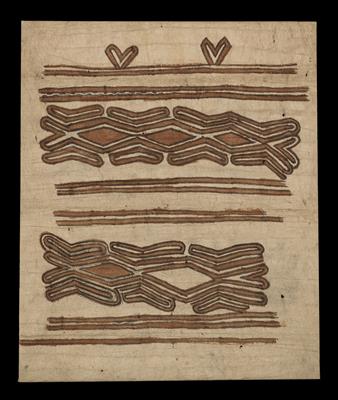New Guinea, Oro Province: a ‘picture’ made of a piece of bark fibre material, called ‘Tapa’, painted with the typical Papuan patterns from the northern coast of southeastern New Guinea (Oro Province).
New Guinea, Oro Province: a ‘picture’ made of a piece of bark fibre material, called ‘Tapa’, painted with the typical Papuan patterns from the northern coast of southeastern New Guinea (Oro Province).

Bark fibre material, called ‘Tapa’, was originally the ‘textile’ par excellence used for the manufacturing of clothing and many other items throughout Oceania. Weaving was unknown (except on a few islands in Micronesia and on Santa Cruz). Bark fibre material was obtained from the inner, softer bark of the paper mulberry. It was detached from the tree in stripes, wetted and applied with overlapping edges. The stripes were subsequently beaten with mallets along the edges and ‘matted’, thus creating larger surfaces (cf. also cat. no. 205). The present ‘picture’ is manufactured with the aforementioned bark fibre material, or ‘Tapa’, and is painted with natural earth colours or vegetable dyes in the style of the Papuan people from the northern coastal region in the southeast of the island of New Guinea. With lines, curves and rhombs in elaborately composed ‘bands’. The precise meaning of these abstract motifs is as yet unknown. Mounted on a wooden frame. No damage. Dimensions: 118 cm x 97 cm. First half to mid-20th century. (ME)
Provenance:
Austrian Private Collection.
Lit.:
'Traditional Tapa Textiles of the Pacific' by R. Neich & M. Pedergrast, ill. p. 146.
Esperto: Prof. Erwin Melchardt
 Prof. Erwin Melchardt
Prof. Erwin Melchardt
+43-1-515 60-465
erwin.melchardt@dorotheum.at
09.06.2016 - 17:00
- Prezzo di partenza:
-
EUR 400,-
New Guinea, Oro Province: a ‘picture’ made of a piece of bark fibre material, called ‘Tapa’, painted with the typical Papuan patterns from the northern coast of southeastern New Guinea (Oro Province).
Bark fibre material, called ‘Tapa’, was originally the ‘textile’ par excellence used for the manufacturing of clothing and many other items throughout Oceania. Weaving was unknown (except on a few islands in Micronesia and on Santa Cruz). Bark fibre material was obtained from the inner, softer bark of the paper mulberry. It was detached from the tree in stripes, wetted and applied with overlapping edges. The stripes were subsequently beaten with mallets along the edges and ‘matted’, thus creating larger surfaces (cf. also cat. no. 205). The present ‘picture’ is manufactured with the aforementioned bark fibre material, or ‘Tapa’, and is painted with natural earth colours or vegetable dyes in the style of the Papuan people from the northern coastal region in the southeast of the island of New Guinea. With lines, curves and rhombs in elaborately composed ‘bands’. The precise meaning of these abstract motifs is as yet unknown. Mounted on a wooden frame. No damage. Dimensions: 118 cm x 97 cm. First half to mid-20th century. (ME)
Provenance:
Austrian Private Collection.
Lit.:
'Traditional Tapa Textiles of the Pacific' by R. Neich & M. Pedergrast, ill. p. 146.
Esperto: Prof. Erwin Melchardt
 Prof. Erwin Melchardt
Prof. Erwin Melchardt
+43-1-515 60-465
erwin.melchardt@dorotheum.at
|
Hotline dell'acquirente
lun-ven: 10.00 - 17.00
kundendienst@dorotheum.at +43 1 515 60 200 |
| Asta: | Tribal Art - Africa |
| Tipo d'asta: | Asta in sala |
| Data: | 09.06.2016 - 17:00 |
| Luogo dell'asta: | Wien | Palais Dorotheum |
| Esposizione: | 04.06. - 09.06.2016 |
